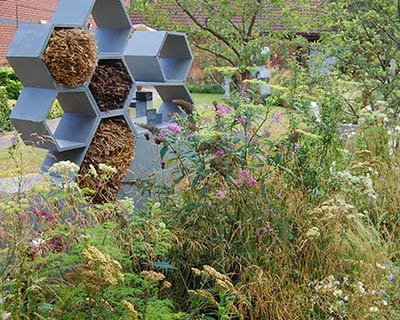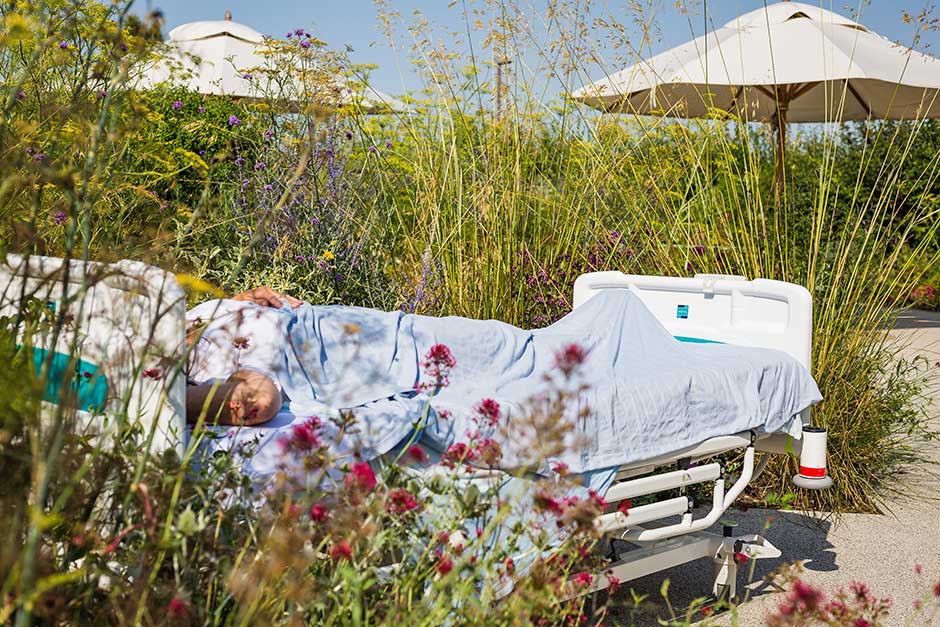Care for all at Cransley Hospice
The wildlife garden that's helping patients find peace and comfort at Cransley Hospice
Colourful heads of Achillea gently nod as a roaming bee forages through its flowers, in search of nectar. A breeze whispers through some nearby fennel and brushes the long fronds of grasses that are scattered through the garden. Catching the wings of the bee, the breeze carries her back to her home in a honeycomb-shaped wall, packed with sticks.
This is the Urban Pollinator Garden. Once standing in the grounds of the RHS Hampton Court Palace Garden Festival, it has now found a permanent home at Cransley Hospice, Kettering, Northamptonshire.
I’m really pleased that the garden can live on,’ says the designer, Caitlin McLaughlin. ‘It’s given it a new life and a space for people and wildlife to come together.’
A home for bees
‘I always knew I wanted to relocate the garden, and we built this wall in sections so that it would be easier to move,’ explains Caitlin
As the space is much bigger at Cransley than the festival, the honeycomb has become more of a feature than a wall, with the two parts now framing the garden.
The honeycomb structure is not only eye-catching, it also plays a vital role in the garden. Packed within the hexagonal sections you’ll find an array of sticks, straw and piles of bee bricks – the perfect home for passing pollinators.'...it really hit home that this garden could potentially be one of the last things some people see'
‘The materials used within the wall help different sized solitary bees,’ explains Caitlin. ‘For example, the plant stems and small holes in the wood can provide a nesting space for scissor bees. These bees are so tiny that they can lay their eggs inside holes made by woodworm beetles.’
The planting in the garden has also been planned with pollinators in mind. Lush borders bursting with life fill a space that was once a bare lawn. Through the whispering long grasses, pops of colour from Verbascum and Achillea add to the calming purple and whites of the scheme and provide plenty of opportunity for hungry insects.
The passage of time
‘It’s really exciting as, while this garden is a snapshot of summer, it’ll look completely different as the year goes on,’ says Caitlin. ‘I like to leave seedheads and grasses through winter, which this garden has in abundance.’
The space has already been utilised by Cransley, with families coming together and residents keen to keep up the maintenance of the garden.
‘Gardens are so good for wellbeing and I wanted to ensure that the people living here have a nice space to enjoy,’ says Caitlin. ‘The residents have been asking about keeping the garden looking its best and I’m really happy for them to make it their own and add to the borders.’
‘I know a lot of staff have already been enjoying the space too. Their jobs can be very demanding and it’s important that they have somewhere peaceful to go. I know they’ve already been enjoying the space at lunch time.’
Many of the rooms in the hospice also look out over the garden, meaning residents can enjoy the space, whatever the time, day or weather.
‘I’ve been talking a lot to the residents about their thoughts on the garden and they’ve said how lovely it is to look out their window and see it,’ says Caitlin. ‘I’m really pleased as I really enjoy making things beautiful and I want this to be something that can help people.'
‘This has become even more poignant as the build has gone on. Being a hospice, the sad truth is that patients pass away. Over just the course of a month, some of the residents have passed away and it really hit home that this garden could potentially be one of the last things some people see.'


